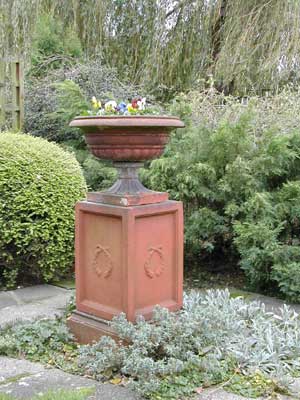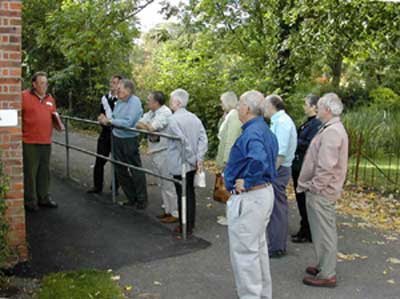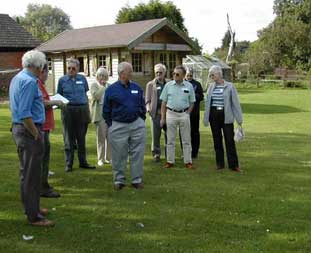|
UPDATE No 35 |
|||||
|
ROOKE & CULL |
|||||
|
|
|||||
|
SAMUEL SOUTH WEBSITE |
|||||
|
The Samuel South website continues to expand and there have been over 1700 visits to the site. Over recent months there have been contacts with; - Chris Johnson who is researching the pottery of G & A Tuck at Waltham Abbey that closed in 1963. - Christine Reed whose father, Leslie Woor, was a long serving potter at Samuel South & Sons until the closure in 1960. - Nikki King whose grandparents lived in Snells Park, the one time home of Samuel(1) at 43 Snells Park and Samuel(2) at number 39. - Tristan White whose great uncle was a director of Direct Mineral Water Supplies (DMWS), the mineral water manufacturers occupying premise close to the potteries in White Hart Lane. - Jim Clifton a descendant of the Field family which occupied River House prior to Samuel South(2). His great aunt, Emily Field, married Arthur South, the brother of Samuel(2). - Julie Perrim the great granddaughter of Joseph Hardisty, a fellow passenger with Joseph South on board the Buckinghamshire during the emigration voyage to New Zealand in 1874. |
|||||
|
OTHER NEWS |
|||||
|
On 21 September 2002, great great grandchildren of Joseph South (1822-1906) went on a tour of the villages of Barley, Barkway and Reed where the South family had lived for several generations (see report on last page). Tom Doig, the local historian, conducted the tour. The following prizes of drinking mugs, uniquely bearing an image of the South "pot" calendar, were won by; Quiz - Jean & Ian Bowyer. Farthest travelled participants - Michael & Hazel Short (New Zealand). A prize should also have been available for the best comment of the day made by John Short. Whilst walking around the grave yard of Reed church and noticing the disturbance caused by the burrowing activities of the local rabbits, he dryly remarked "Is that caused by rabbits or is someone trying to get out?" Margaret Baker, who is married to a descendant of Henry South, paid a visit on 6 October 2002. Henry was a younger brother of Joseph South and emigrated to Australia in 1853. Margaret was taken on a tour of the Hertfordshire villages connected with the Souths. The Archive has been invited to contribute towards a book about the Lea Valley Industry to be published by Harris Digital Productions in association with Lowewood Museum, Hoddesdon. |
|||||
|
SOUTH DAY QUIZ |
|||||
|
After the tour the following quiz was set by Tom Doig (answers at foot of page); 1. Many members of the South family are buried in Barley churchyard. To which Saint is the church dedicated? 2. Alfred South (who, as usual, sometimes called himself Bysouth) was a very smartly dressed man. He married Naomi Dockerill in 1868 at Barkway. He was neither a potter nor a brickmaker! What was his trade? 3. When Ann Bysouth died in 1844 at Royston Workhouse, she left a box, cloaked in mystery, that the Board returned to her daughter in law, Ann Bysouth. What was in the box? 4. In August 1869, Arthur South died in an accident with a relatively new fangled device at Barnet while not on his guard. His epitaph in Royston Cemetery might have mentioned that he 'laid his life on the line.' How did he die and what was his occupation? 5. Henry & Elizabeth South/Bysouth had a child baptised at Reed in 1744. The Register reads, 'which was the desire of the mother of the child that it should be so called.' What name was given to the child? 6. When John South was buried at Reed in 1690, the parish clerk added at note in the register that reads, 'in woollen.' Why did he consider that this was important? 7. Sarah Unwin married John South in 1849. Later members of the family owned the Unwin chain of wine merchants. a) Her family was not always called Unwin. What other eye-watering name did they have? b) The Unwins were not the only South connection with the drinks trade. What distillers of gin were related to the Souths? 8. In 1853 John and Sarah South from Barley emigrated to Victoria, Australia. They travelled on a ship named after a tyrant whose father had built 'a stately pleasure dome' at Xanadu. What was the ship called? 9. Another emigrant family were Joseph South/Bysouth, potter, and his wife, Mary Ann, from Barley and Edmonton. They left England on 7th March 1874 and reached their totally dark destination in May. To what country did they emigrate? 10. Mary Ann was Joseph's second wife. In total, how many children is it recorded that Joseph fathered?
Answers: 1) St Margaret of Antioch; 2) Tailor; 3) Clothes; 4) Railway guard - run down by train; 5) Darenter; 6) Woollen Act 1666 imposed fine for other material used; 7a) Onion; 7b) Gilbey; 8) Ghengis Khan; 9) New Zealand; 10) 18. |
|||||
|
The following report appeared in the news section of the Lowewood Museum, Hoddesdon, website www.lowewood.com |
|||||
|
KLB 12/02 |


